
Should You Use AI to Create SEO Content? Insights from 150 Content Leaders

Vivien Magyar

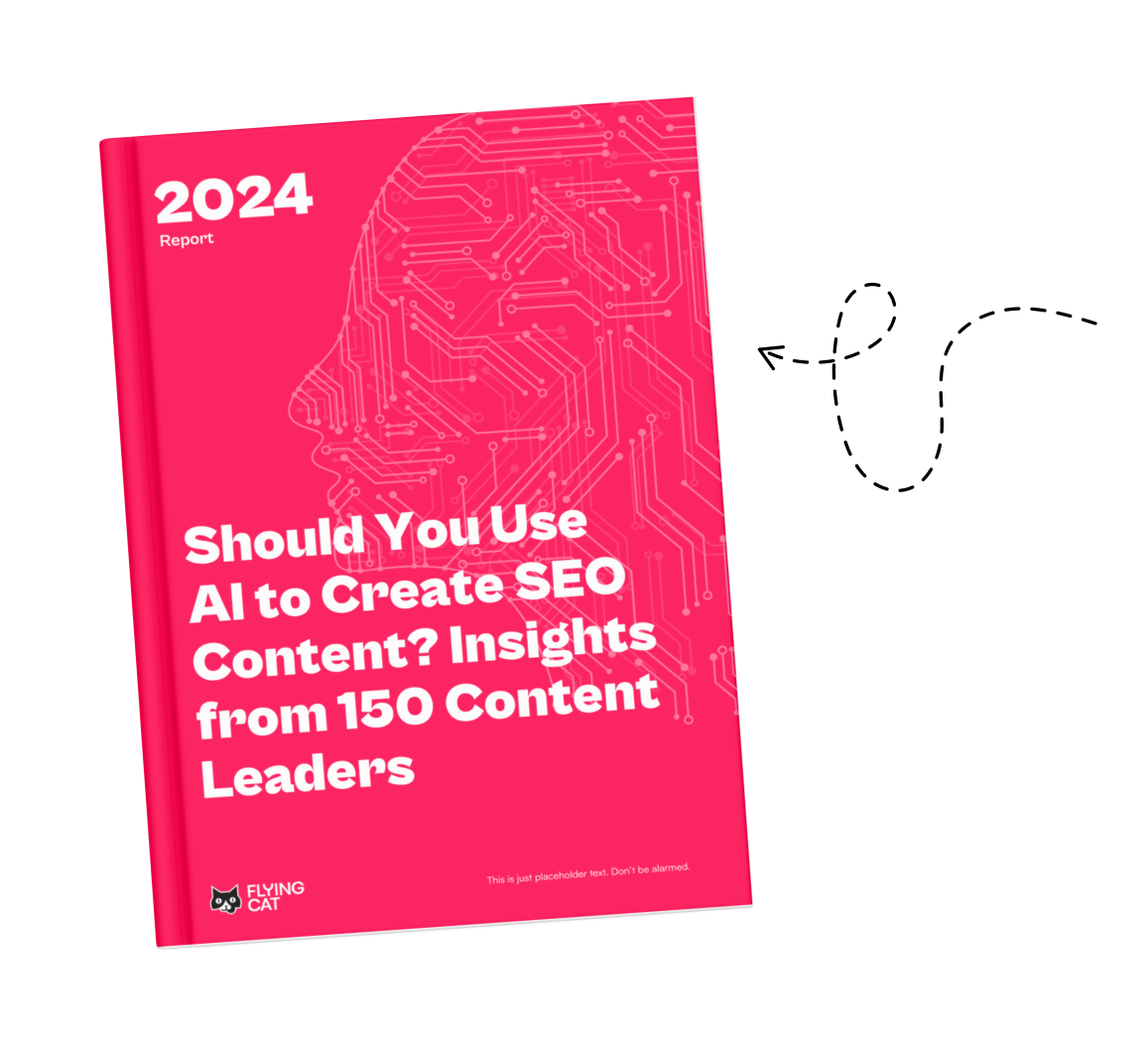
Key takeaways:
-
The extent of AI usage in content production does not significantly impact content performance.
-
Factors that influence traffic outcomes include company and in-house content team size, investment per piece of content, and use of EEAT signals.
-
The biggest advantage that AI provides is a productivity boost: 1 in 5 teams experienced over a 50% increase in productivity from using AI.
-
AI has the potential to positively impact the bottom line for SEO, as long as it’s used in conjunction with human expertise.
Introduction
And then AI was everywhere
The explosion of generative AI tools over the past couple of years led to a proliferation of AI-generated content, sparking questions in the digital marketing community.
Does human-written content perform better than purely AI-generated content? Does Google treat human-written articles differently than AI-written ones? Can companies use AI to improve efficiencies and increase their bottom line while simultaneously protecting their brand’s reputation?
Some SEO experts caution against the overuse of generative AI, while others champion its ability to create content at scale.
There’s no shortage of experimentation. Just think of the viral “SEO heist”, when an agency stole millions of organic traffic from a competitor by downloading their sitemap, turning the list of URLs into blog titles, and using AI to generate over 1,800 pages. The heist was successful for four months, resulting in a spike in traffic before plummeting and setting the website back two years.

There are plenty of companies that are willing to resort to black-hat techniques for the sake of rapid (if unsustainable) traffic gains.
But there are also thousands of well-meaning content teams around the world who just want to save a few hours here, cut a few dollars there by automating repeatable processes without being penalized. And if AI can help them do that, why not take advantage?
Chasing content quality
The Google March 2024 Core Update shook the entire SEO community to its core. It was the most complex and highest-impact algorithm update in Google’s history, with a goal to improve the quality of search by drastically reducing low-quality, unhelpful, and unoriginal content.
The update involved changes to multiple core systems (automated ranking systems that use signals from hundreds of billions of web pages to provide relevant search results) and took several weeks to roll out.
Notably, it included three new spam policies to address bad practices that were hurting the quality of search results: expired domain abuse, scaled content abuse, and site reputation abuse.
Following the release of the update, Google completely de-indexed hundreds of low-quality websites. Unsurprisingly, a lot of them had AI-generated content. Originality analyzed 14 of the de-indexed websites and determined that all of them had published AI-generated content, and 7 of them had more than 90% of their content written by AI.
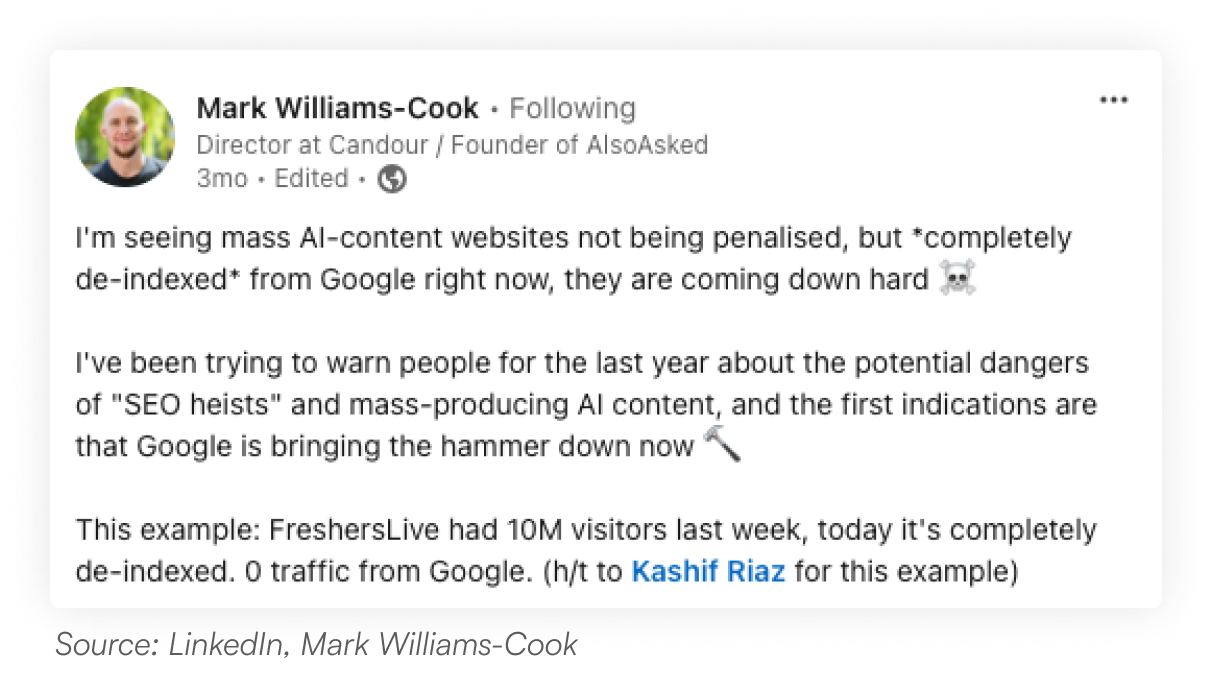
On the other hand, there were reports of websites without AI content getting penalized (if not de-indexed), too. This proved Google’s claim that they aren’t going after AI content: they care about content quality, not how the content was created. It’s not AI content that Google penalizes, but low-quality content - which is often the result of someone trying to manipulate the algorithm and get hastily and cheaply-made content to rank.
The Core Update scare was enough to get marketing leaders to start questioning whether using AI to speed up content production might backfire. The threat of getting penalized - and potentially suffering irreparable losses - was suddenly very real. They all started wondering how to keep cutting costs and improving margins while ensuring they stay on the good side of Google and protect their brand reputation.
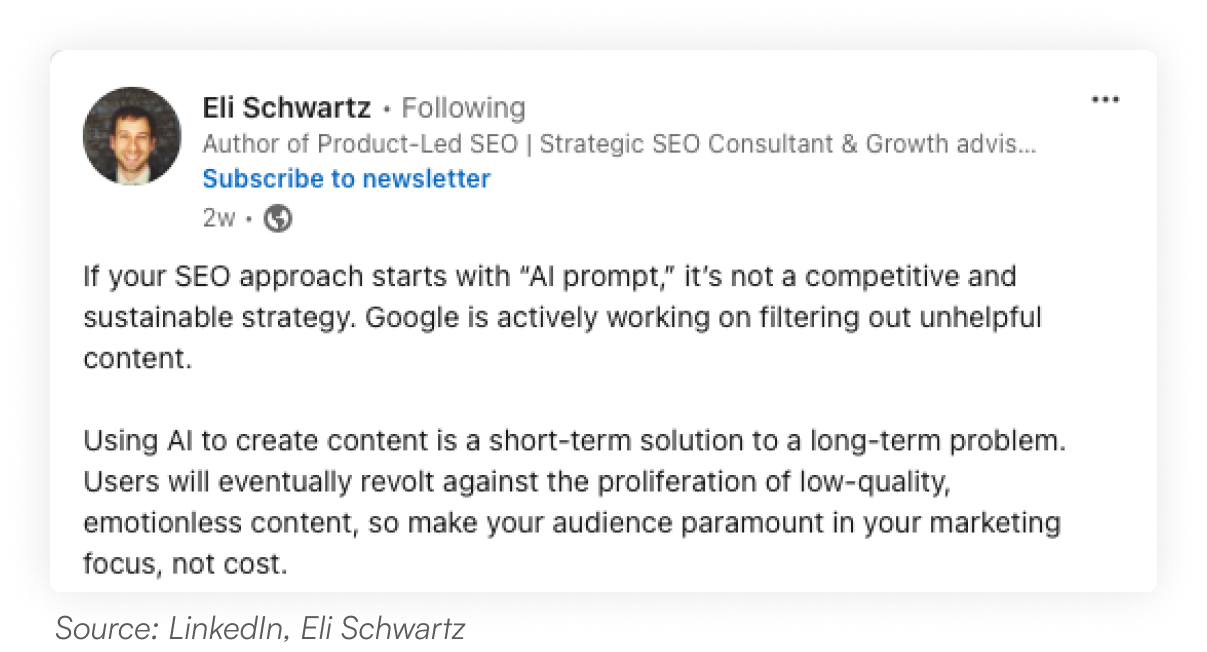
Seeing these doubts arise in the industry and getting questions from our clients about AI best practices led us to want to dig deeper and compile this report.
The questions we wanted answered:
- How do real-life content teams actually use AI?
- How much AI is too much? Can content teams use some AI without compromising their standing with Google? And how much is “some”? Where do we draw the line?
- Whether using AI or not, how can content teams ensure their content lives up to Google updated quality standards?
Methodology
How we made this report happen
To get to the bottom of it, we sent out a survey and asked nearly 150 content leaders to report on how they use AI and how it has affected their productivity and their content’s performance.
Who contributed
We received 147 responses from content leaders with various job titles, working in various industries, for companies of different sizes.
We gathered insights from:
28 Heads of Content
25 Content Managers
22 SEO Specialists
17 Marketing Directors
14 Content Marketing Leads
and 41 content professionals with other titles.
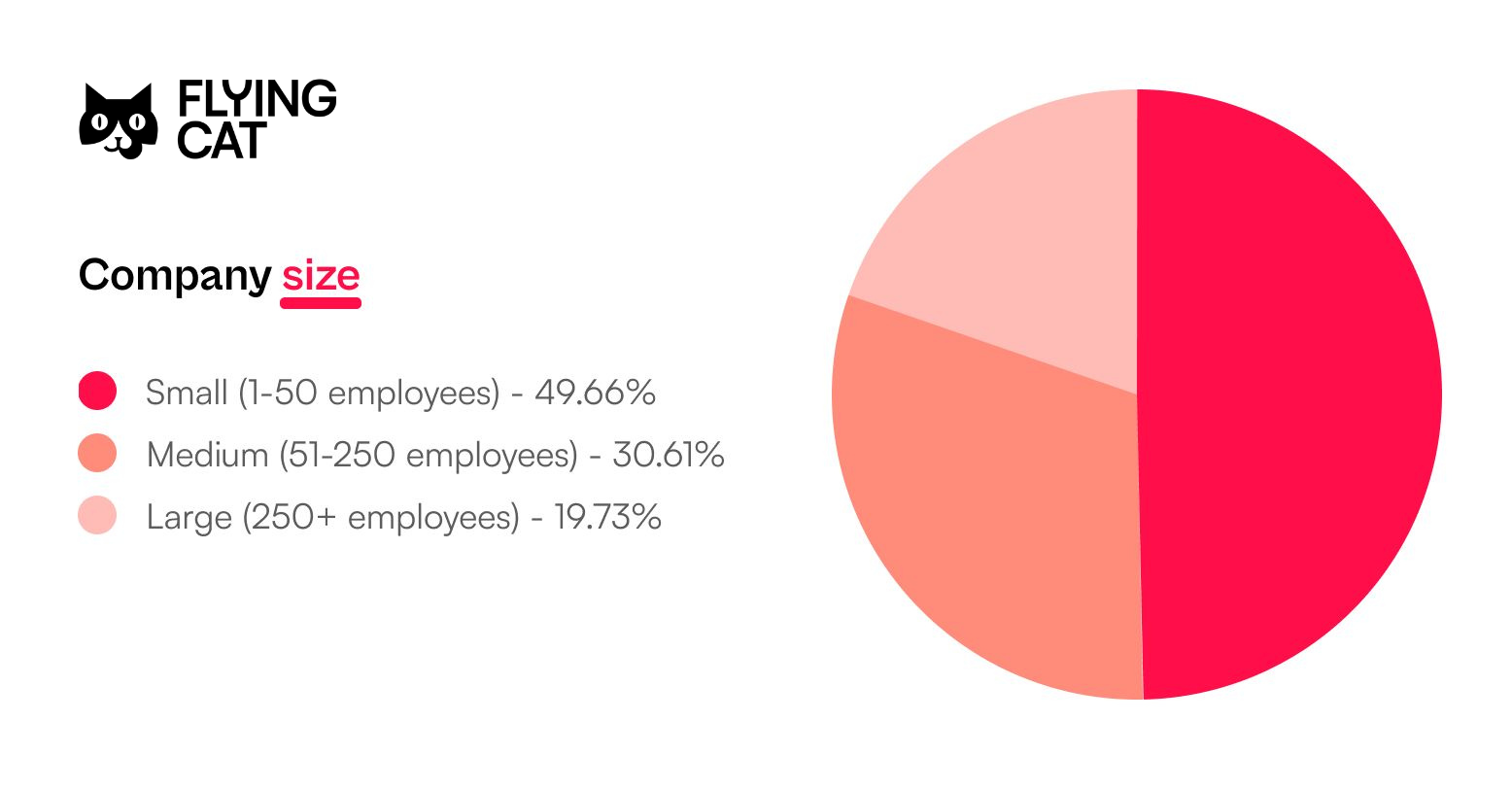
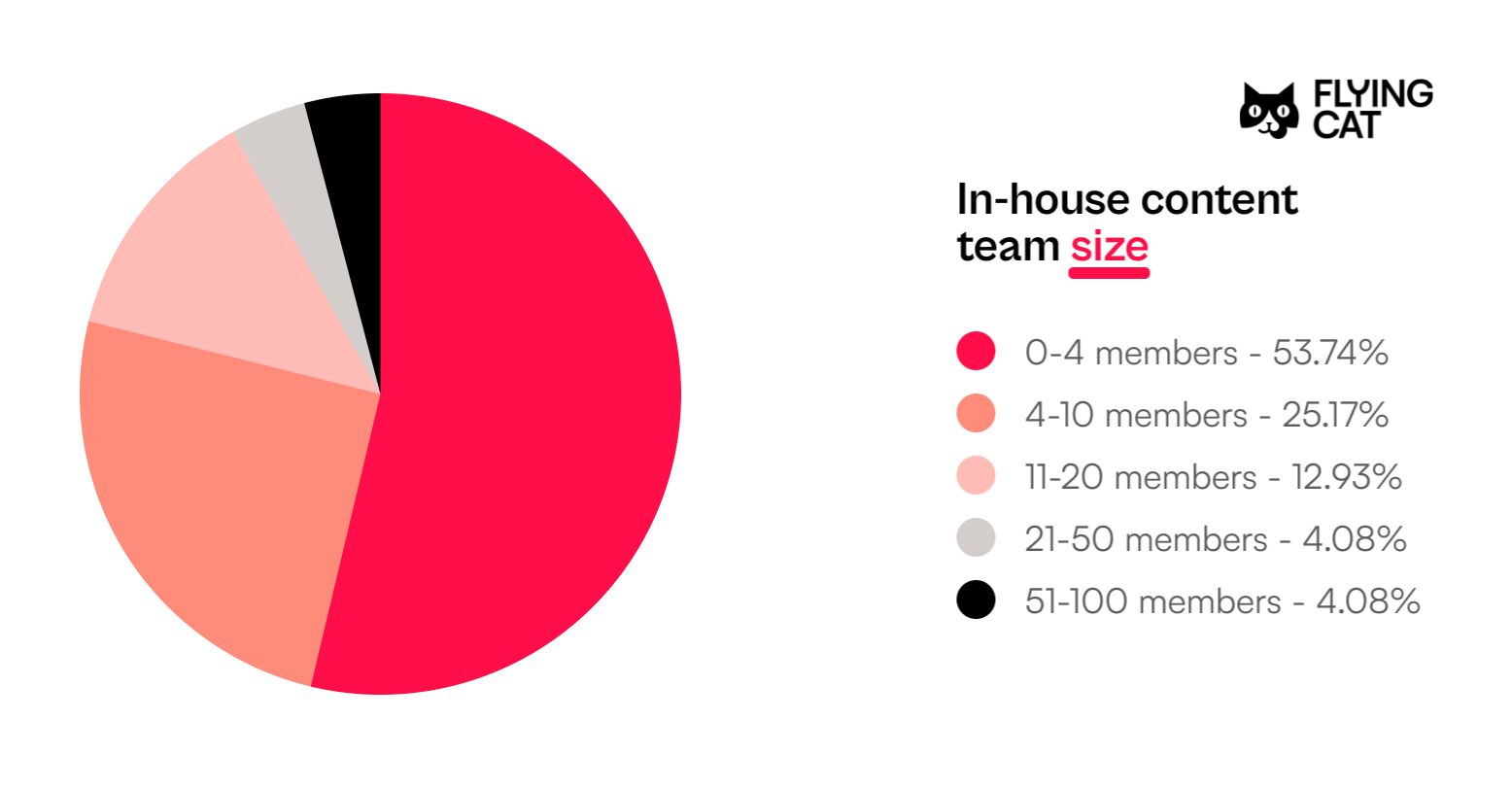
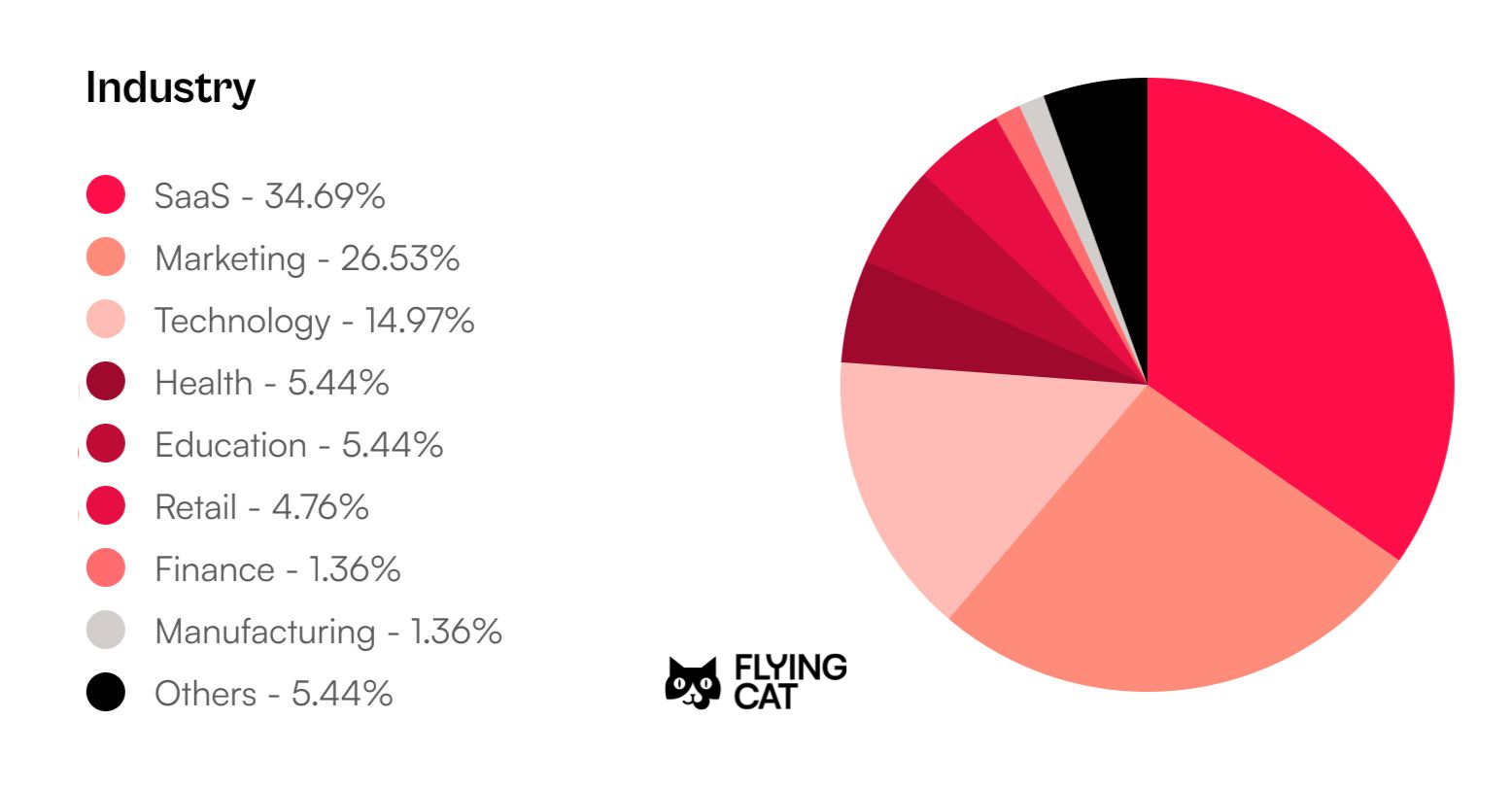
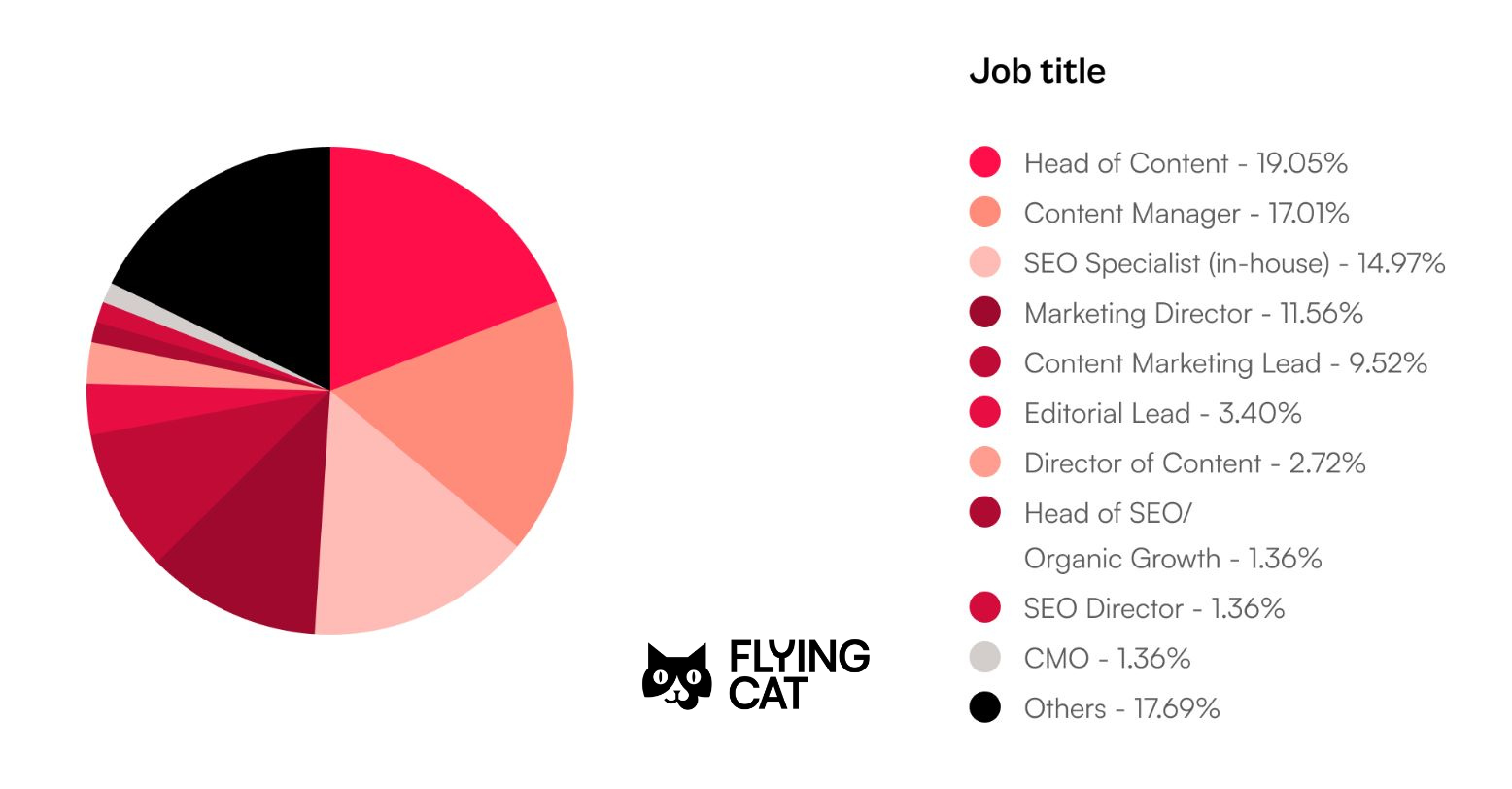
Table of Contents
- Part 1: How do content teams actually use AI?
- Part 2: Does AI usage affect content performance?
- Part 3: What other factors influence content performance?
- Part 4: The future of AI in SEO content
Part 1: How do content teams actually use AI?
Most content teams either don't use AI at all or only use it for subtasks rather than generating entire blog posts
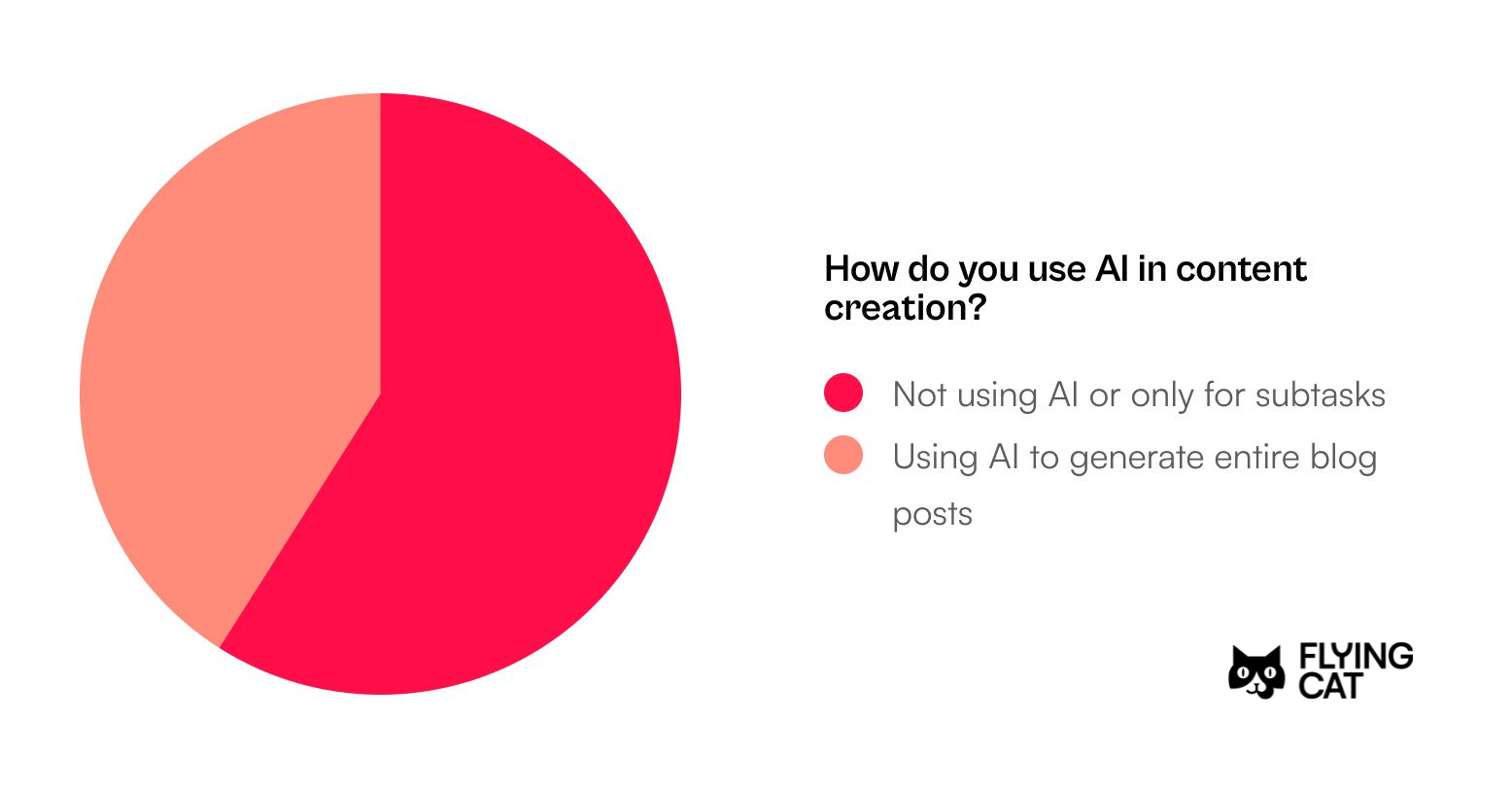
The majority of content teams surveyed (59%) restrict their use of AI to certain subtasks of the content creation process, such as ideation and keyword research, generating outlines, research assistance, writing simple content sections, and editing.
“I don't think AI is helpful for writing net new long-form content right now. I've tested out generating blog posts and have tried to get really specific with my prompts/outlines, but based on the amount of editing required to get something I'd be comfortable publishing, it's still more efficient to have humans write that content from the beginning,” one respondent noted.
Another respondent said that generating “one-shot” blog posts and publishing them with minimal to no human input “dumbs down the search results”, adding that Google is right to take action against these practices.
In contrast,
41% of the surveyed teams use AI to generate entire blog posts
which are then either heavily edited or lightly proofread by humans.
As one respondent explained, their strategy is “creating fully AI-generated pieces at scale and optimizing the top performing content”. The same respondent said they are planning to use AI “extensively” over the next year, “putting out hundreds of pages each month and then refining the best performing with human intervention to improve quality”.
It’s important to note that those who use AI to generate content from scratch aren’t necessarily using it to generate long-form thought leadership articles—but they may be using it to write basic content like FAQs and glossary pages.
What’s more, only 10% of respondents said they publish AI-generated blog posts with less than 50% human input—the rest use human editors more extensively.
Content teams are six times as likely to use AI for generating outlines than generating entire blog posts with minimal human input
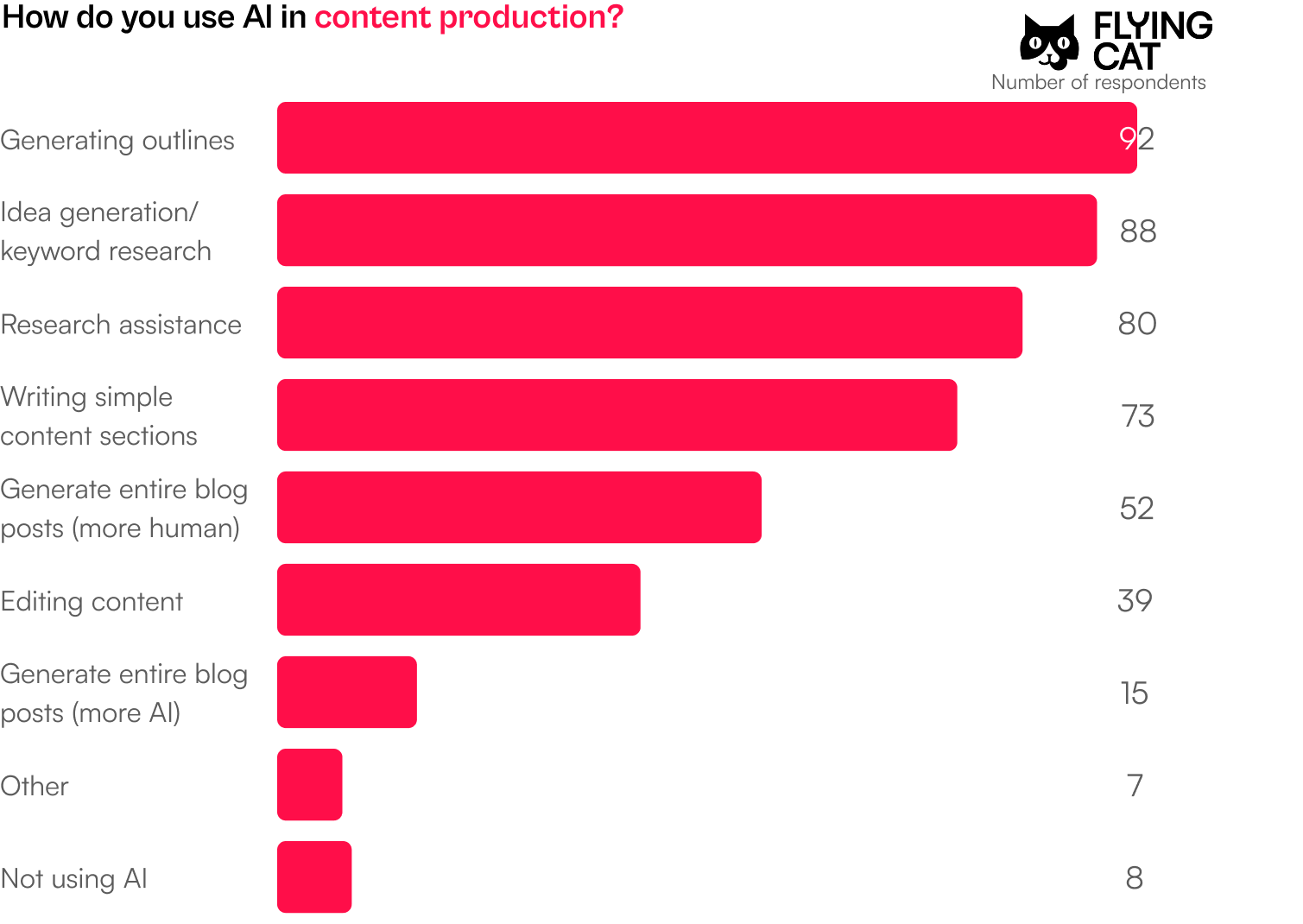

- The most common use of AI is generating outlines (63%), followed by idea generation and keyword research (60%).
- 54% of respondents use AI for research assistance, while 50% use it for writing simple content sections and 27% use it for editing.
- 35% use AI to generate entire blog posts heavily edited by humans (where the extent of AI contribution is less than 50% of the output).
- Only 10% use it to generate entire blog posts lightly proofread by humans (where AI contributes more than 50% of the output).
When asked where AI is most useful in the content creation process, many of the respondents mentioned the following:
- Ideation and brainstorming
- Paraphrasing
- Proofreading and editing
- Finding content gaps
- Structuring and organizing content
- Summarizing
- Identifying patterns
- Outlining and creating content briefs
- Writing short sections of content
- Generating glossary pages, FAQs and wikis
- Writing meta titles and meta descriptions
- Programmatic SEO
- Overcoming writer’s block/eliminating the blank page syndrome
More than twice as many teams use AI to create top-funnel SEO articles compared to thought leadership articles
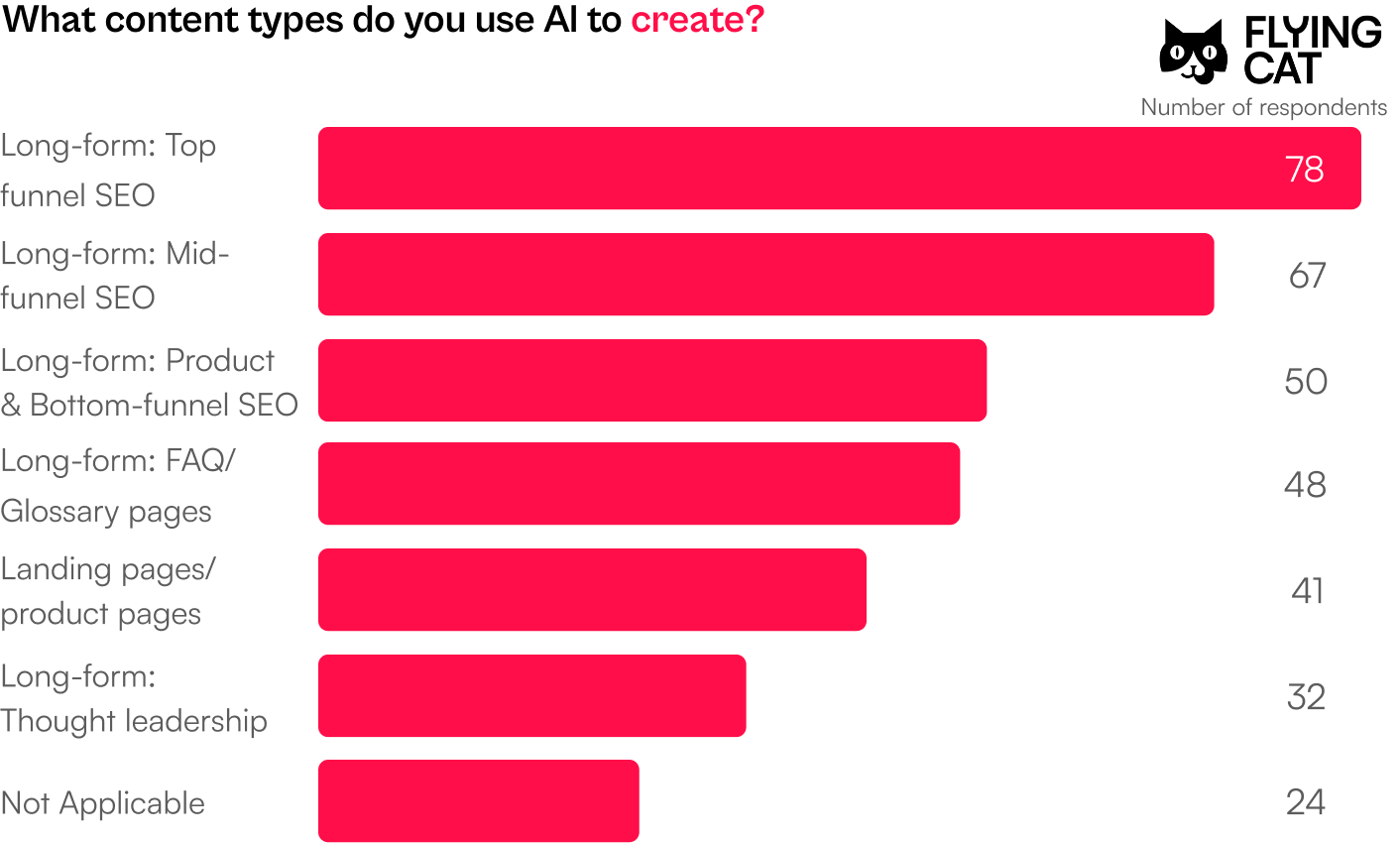
When it comes to the type of content teams use AI to create, the frontrunners are top-funnel and mid-funnel SEO articles, with 53% and 46% of respondents using AI to create them, respectively. (This doesn’t mean that all the respondents are using AI to generate TOFU and MOFU articles from scratch—they may be restricting their AI use to keyword research, outlining, etc., when producing these articles.)
Unsurprisingly, thought leadership articles are the type of content that AI is least used for, with

at some point during the content production process.
Many respondents agree that creating thought leadership content is not one of AI’s strongest suits.
As one respondent put it, AI is not “as useful when it comes to creating highly nuanced, opinion-based, or emotionally engaging content”. They went on to say that AI can “lack the human touch and fail to connect with readers on a deeper level, which is important for building brand loyalty and establishing thought leadership”.
Another respondent said: “When it comes to hyper-specialized niche topics, I find the AI is still a little too clumsy [...]. One workaround is for the SME to provide a list of bullet points covering the topic, then ask the AI tool to expand them.” Even so, they added that the content needs “a careful human hand to make sure everything is accurate and adequately expressed”.
Almost half of the teams who use AI only started using it in the past 6 months
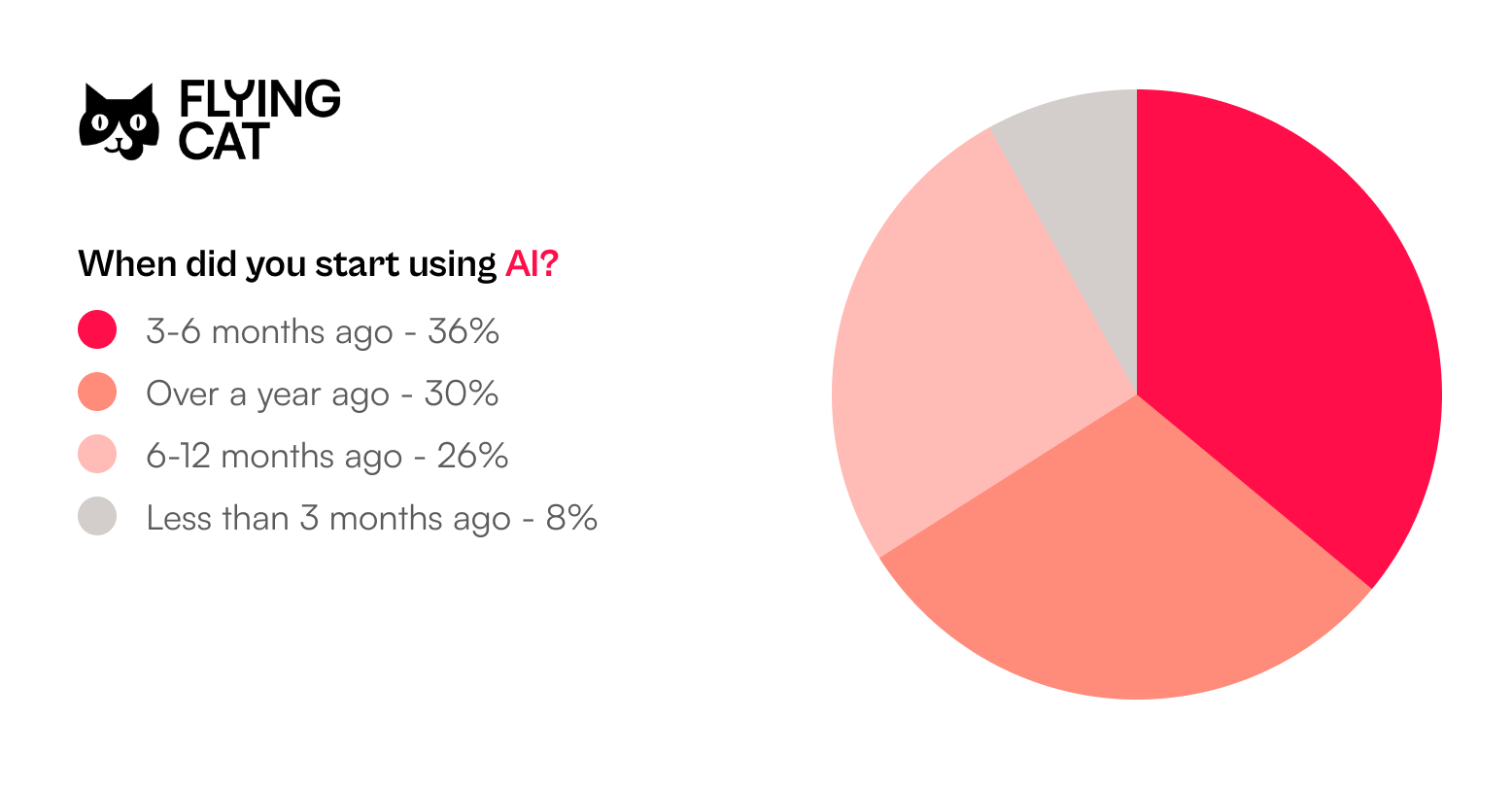
Out of the 128 teams who use AI in their content creation processes, 8% started using it less than 3 months ago, 36% started 3-6 months ago, 26% started 6-12 months ago and 30% started over a year ago.
44% of teams have been using AI for less than 6 months
A large portion of them are likely still in the experimentation phase, where they’re learning to use the tools at their disposal but may not have fully optimized their processes yet.
The learning curve for some AI tools can be steep (smart prompting is an art and a science), not to mention that establishing AI usage guidelines within organizations takes time.
“Using AI properly is an iterative process, treating the tool as an assistant rather than a crutch,” one respondent noted.
Another respondent echoed these thoughts by saying the key is “proper, thoughtful prompting” and “patience and a willingness to spend sufficient time with the tools, rather than using them as clumsy shortcuts.”
ChatGPT is the most-used AI tool, followed by Jasper and Gemini

AI truly is everywhere - the content leaders we surveyed listed more than 120 different tools with AI capabilities that they use in their content production process.
It’s no surprise that ChatGPT won out, with twice as many content teams using it as the next most popular tool, Jasper.
The respondents cited dozens of tools that don’t fall into the AI chatbot category but possess some AI functionalities, including popular SEO and keyword research tools like SurferSEO, Semrush, Ahrefs and Clearscope.
Notably, about 5% of respondents use a proprietary or custom GPT built on existing AI models.
Part 2: Does AI usage affect content performance?
There's no correlation between AI usage and content performance
Since the aftermath of the Google March 2024 Core Update had many content teams regretting their over-enthusiasm for putting out AI-generated content, it may come as a surprise that our survey found no correlation between the extent of AI usage in content production and content performance. Let’s break it down.
To analyze, we split the respondents into four groups:
- Do not use AI
- Only use AI for subtasks (idea generation/keyword research, generating outlines, research assistance, writing simple content sections, and editing content)
- Use AI for generating entire blog posts, heavily edited by humans (AI contribution less than 50% of output)
- Use AI for generating entire blog posts, lightly proofread by humans (AI contribution more than 50% of output)
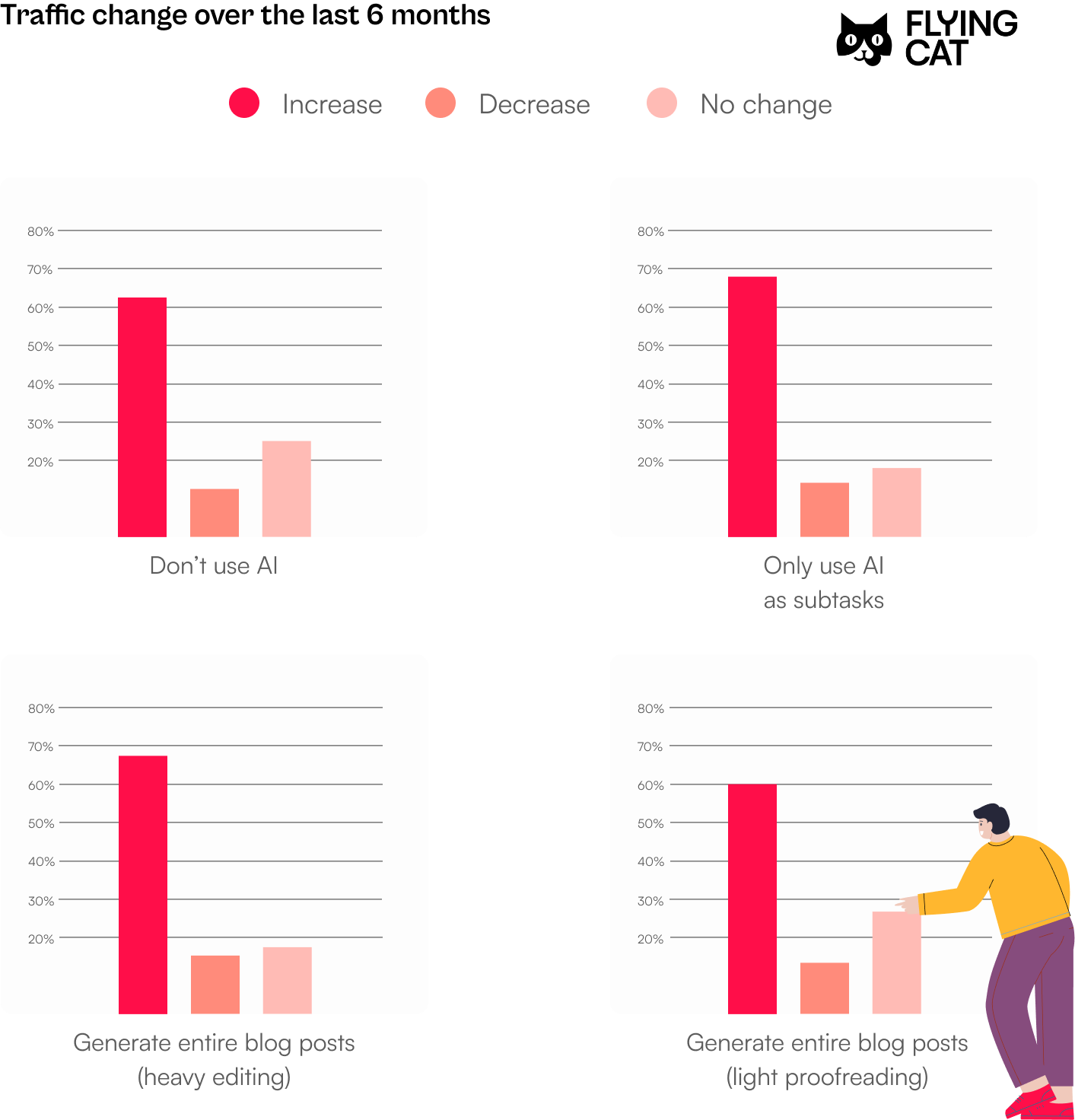
In the last 6 months:
- 98 respondents (67%) reported a slight or significant increase in traffic
- 28 respondents (19%) reported no change
- 21 respondents (14%) reported a slight or significant decrease
The group that used AI the most extensively (to generate entire blog posts with less than 50% human contribution) had the lowest percentage of respondents who reported a traffic increase (60%), but it was only slightly lower than those who do not use AI at all (62.5%).
So, whether a team used AI more or less extensively in their content creation process does not seem to have impacted their results.
One respondent who reported a positive traffic increase remarked: “I believe our positive results come from providing value for the reader. It doesn't matter what tools we use to produce that value, we just need to have high quality, valuable articles that actually help readers and build trust with the domain on which they're published.”

Similarly to the traffic results, the group that leaned the most heavily on AI had the lowest percentage of respondents who reported an increase in conversions (60%). But it was only slightly lower than the group that had the highest percentage (64%) - the group that uses AI only for subtasks.
Multiple respondents noted that they don’t find AI particularly useful in creating bottom-funnel, conversion-focused content - especially when it comes to describing product benefits and features, or comparing against competitors.
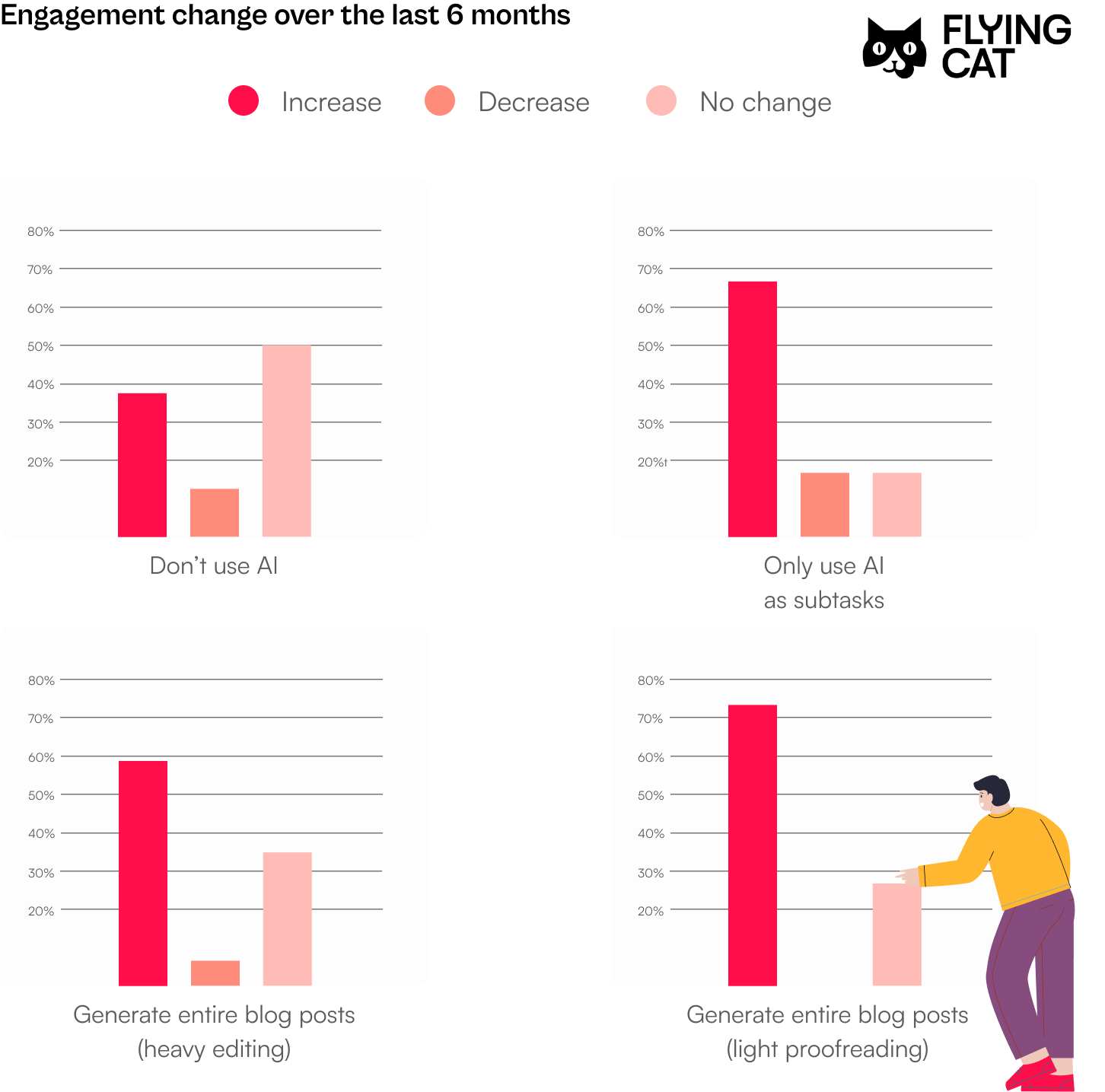
Curiously, the group with the biggest reliance on AI had the highest percentage of those who reported an increase in engagement (73%), versus the no-AI group, where only 38% reported an increase. (We defined engagement metrics as pages per session, time on page, and social shares.)
There could be a few possible explanations for this. For example, teams who use AI to generate content may have been able to increase their content production enough that it resulted in a bump in engagement.
1 in 5 teams increased their productivity by more than 50% by using AI
While traffic, conversion and engagement don’t seem to have been significantly impacted by AI usage habits, productivity has.
While most teams who use AI increased their content output by 1-50%, one in five teams experienced at least a 50% boost in productivity by using AI tools.
According to one respondent, the main benefit of AI lies not in driving SEO results but in “helping a small team produce and execute”.
Another respondent agrees that the main way AI impacts the bottom line is by “making content cheaper and faster to produce”.
Yet another respondent, whose team increased its capacity to produce new content by 22%, warned that the productivity boost “doesn't mean that the creative process can be completely standardized as a factory process.”
“The nuances of the creative process must be protected in order to maintain the content fresh and feed the innovative thinking,” they added.
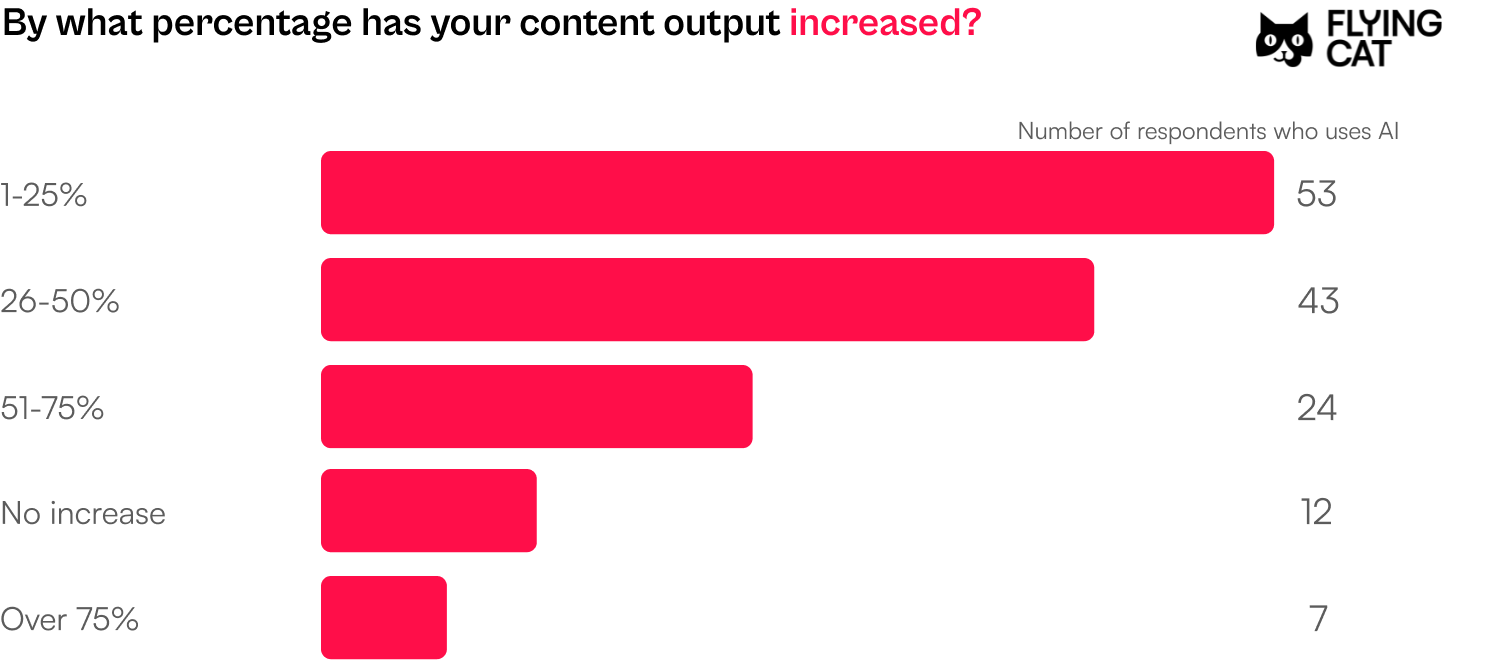
While traffic, conversion and engagement don’t seem to have been significantly impacted by AI usage habits, productivity has.
While most teams who use AI increased their content output by 1-50%, one in five teams experienced at least a 50% boost in productivity by using AI tools.
According to one respondent, the main benefit of AI lies not in driving SEO results but in “helping a small team produce and execute”.
Another respondent agrees that the main way AI impacts the bottom line is by “making content cheaper and faster to produce”.
Yet another respondent, whose team increased its capacity to produce new content by 22%, warned that the productivity boost “doesn't mean that the creative process can be completely standardized as a factory process.”
“The nuances of the creative process must be protected in order to maintain the content fresh and feed the innovative thinking,” they added.
Part 3: What other factors influence content performance?
Bigger in-house content teams workign at larger companies had a better chance of increasing their traffic than smaller ones

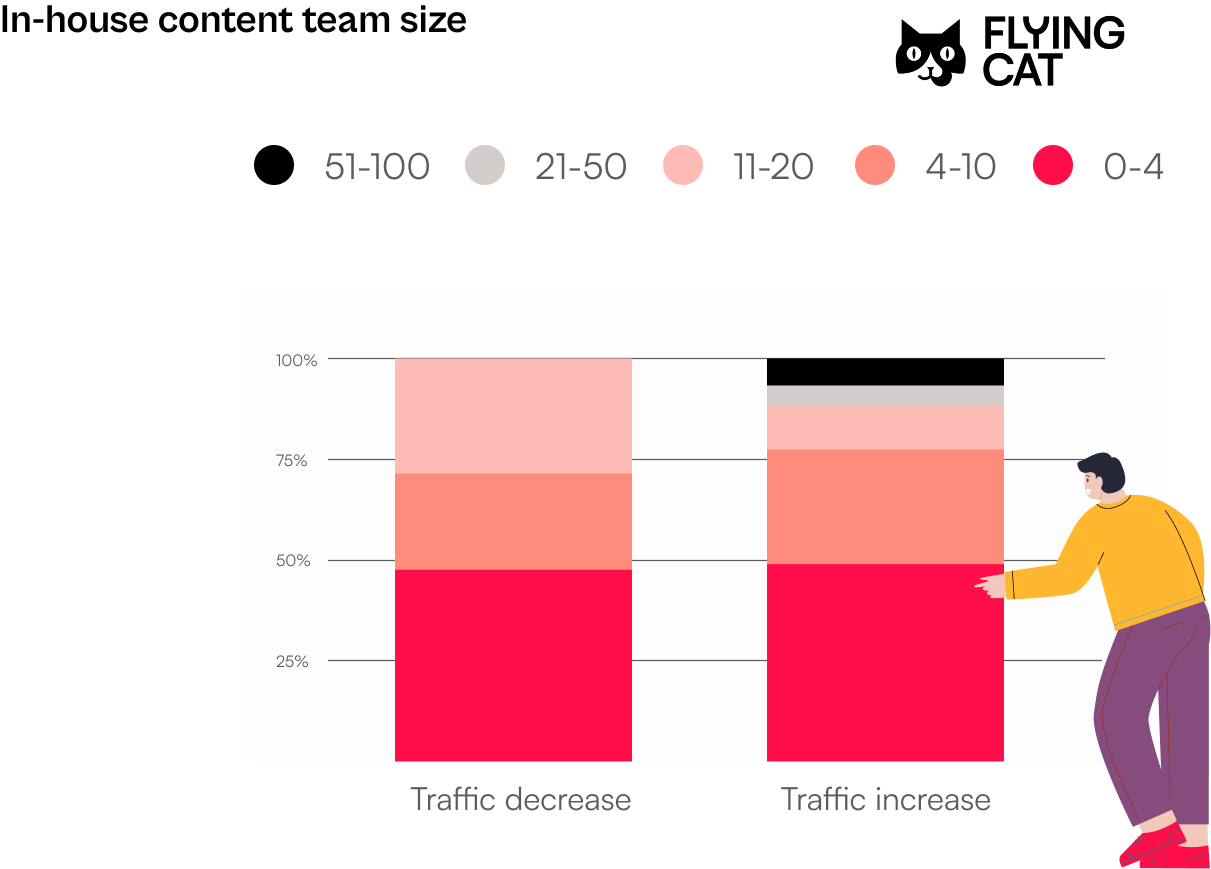
A higher percentage of those who reported a traffic increase work at large companies with more than 250 employees than those who reported a decrease.
Similarly, the traffic increase group has a higher percentage of large content teams compared to the traffic decrease group (which has no content teams with 20+ members).
Larger teams have a larger capacity and are able to produce a larger volume of content - the higher publishing velocity could contribute to better traffic results.
Spending more on SEO content per piece improves traffic outcomes
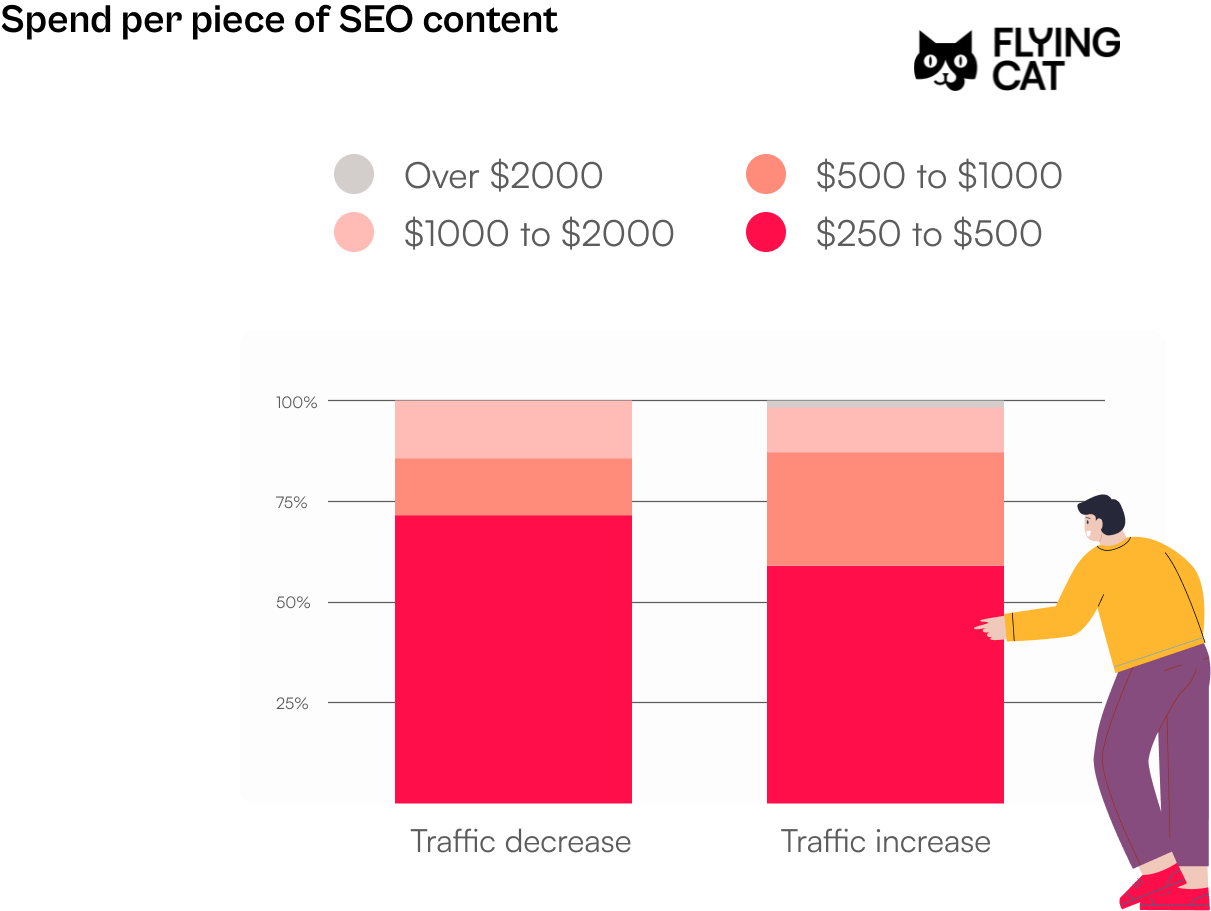
Traffic outcomes were also impacted by how much content teams spend on SEO content.
Those who reported a traffic increase had, on average, spent more on SEO content per piece than those who reported a traffic decrease.

40% of the traffic increase group spends more than $500 per content piece
while only 29% of the traffic decrease group spends as much.
The skill level of the professionals involved in the content creation can also influence outcomes.
29% of those who reported a traffic decrease use a budget outsourced writer to create (some of) their content, while only 14% of those who reported a traffic increase work with budget freelancers.
An equal percentage (19%) of both groups work with premium outsourced writers.
43% of the group who reported a traffic increase use senior in-house content writers versus 33% for the traffic decrease group.
Using more than one type of EEAT signal may contribute to better traffic outcomes
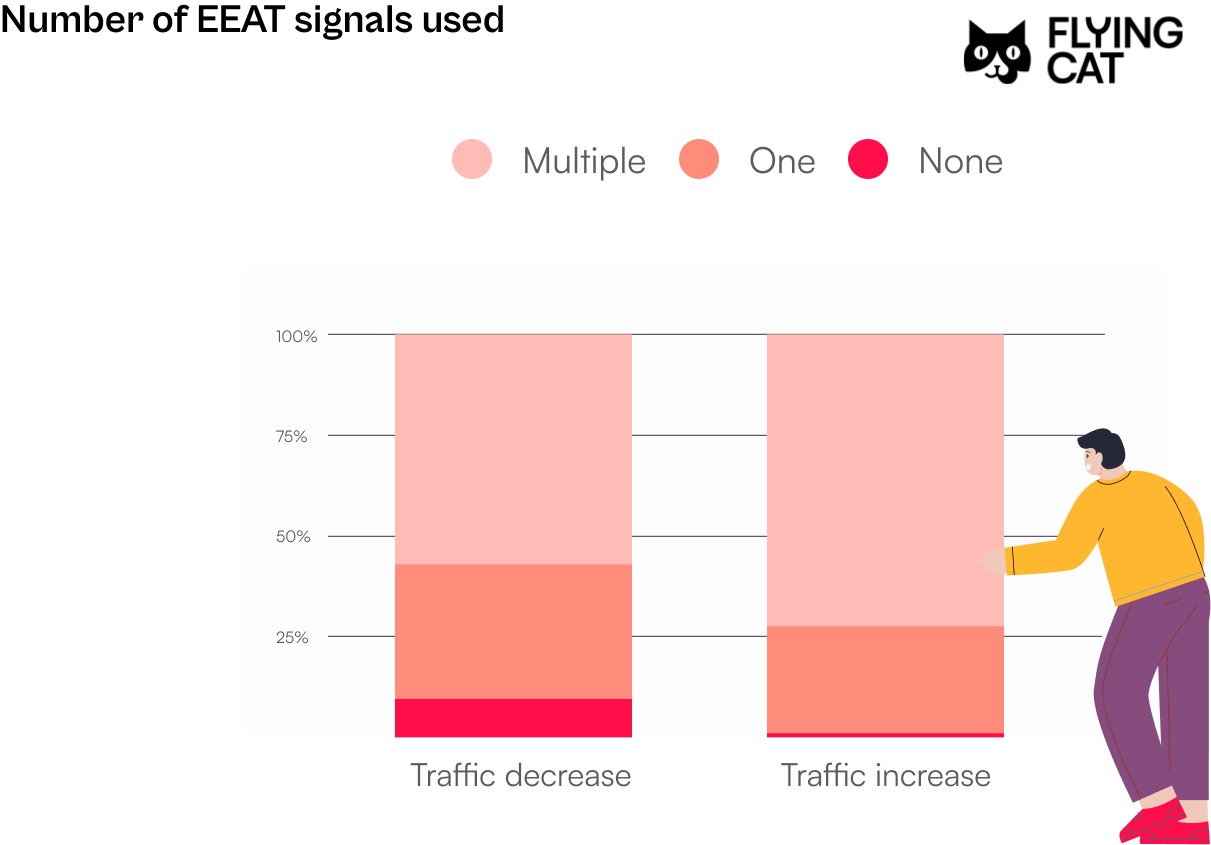

EEAT (Experience, Expertise, Authoritativeness, and Trustworthiness) is a so-called “Quality Rater”, or a part of the guidelines Google uses to evaluate search results.
72% of the group who reported a traffic increase uses multiple EEAT signals
while only 57% of the group who reported a traffic decrease does so.
Out of the traffic increase group, only 1% uses no EEAT signals, while this number is 10% for the traffic decrease group.
This may indicate that putting more effort into demonstrating EEAT indirectly translates into better traffic outcomes.

"By allowing anyone to write content using tools like ChatGPT, AI has leveled the playing field. This is bad news for lazy writers and strategists, because they'll be replaced by AI in no time. But it's good news for those who want to do hard work, because they'll get a chance to stand out. If used well, AI can be an incredibly effective tool to speed up our thinking and creative processes. Those who use it to boost human creativity will have an unbeatable advantage over those who are just looking for shortcuts."
Maeva Cifuentes
Founder & CEO at Flying Cat


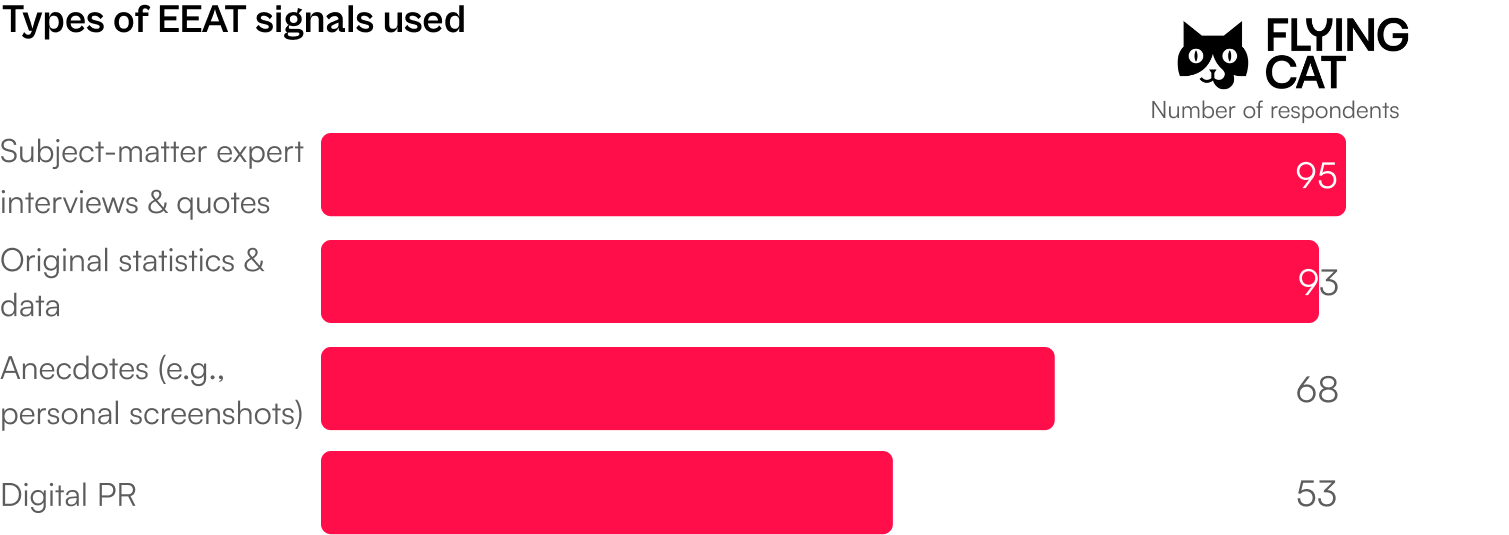
When it comes to what EEAT signals teams are using in their content, our survey found that SME interviews and quotes are the most common form of demonstrating EEAT, used by 65% of all respondents.
This is closely followed by original statistics and data, used by 63% of respondents, and anecdotes, used by 46%.
Digital PR is the most underused EEAT signal with only 36% of respondents taking advantage of it. This may be an area where content teams are missing out, considering that out of those who did use digital PR, 72% had a traffic increase and only 13% had a traffic decrease.
Part 4: The future of AI in SEO content
In the future, AI will be crucial for SEO content creation...

The majority of the content leaders we surveyed foresee a future where AI has become an intrinsic part of content creation.
80% of the survey’s respondents say that, on a scale of 1-10, the importance of AI in creating competitive SEO content will be at least a 6.
Most of the respondents said that they plan to keep using AI as they have been using it so far. At the same time, they’ll keep an eye out for advancements in AI technology, as well as Google’s future algorithm updates. Many highlighted the importance of continuous learning, iteration, and experimenting with prompts.
... and human involvement will be more crucial than ever
When asked what they attribute their positive performance to, many respondents cited reasons that AI has helped them with, like increased efficiency and greater publishing frequency.
However, even more of them cited things that specifically require human involvement, such as subject matter expertise, a strong point of view, and a user-first approach.
For many respondents, these learnings will influence the way they use AI in the future.
As one content leader put it, they will use AI “only as a driver of efficiency, not as a driver of innovation, thought leadership, and certainly not a replacement of people”.
As we mentioned above, AI lacks the uniquely human sensibilities that are essential to creating content that resonates—and drives results.
The way one respondent put it: “When it comes to understanding and aligning with the core values of our brand, AI can assist, but it doesn't fully grasp the nuanced and emotional connection that our brand intends to make with our audience.”
Another respondent echoed their thoughts, saying that AI isn’t able to “deeply understand an audience's specific needs or keep a consistent brand voice. It also struggles with more complex and creative content strategies that require detailed industry knowledge or a personal touch.”
As a third respondent pointed out, AI lacks “the intuition, creativity, and human touch required to produce truly unique and compelling narratives. AI may struggle with understanding context, nuance, and cultural sensitivity, which are essential for crafting engaging and authentic content.”
So, should you use AI to create SEO content?
If it increases your team’s efficiency and allows you to put out more content at a lower cost, by all means—have at it!
The focus should always be on providing value to the end user and meeting Google’s content quality standards to avoid penalties.
No matter how you use AI in your content creation process, you’re still going to need humans to edit, fact-check, verify, and add that elusive human touch that’s so crucial to connecting with other human beings.
If you need help, Flying Cat has an amazing (human!) content team who specialize in long-form, thought leadership content that’s sourced from subject matter experts and demonstrates EEAT.
How Flying Cat can help you rev up your
organic growth
Flying Cat is a full-service SEO and content agency. Whether you’re looking to accelerate your organic growth or expand into new markets, our team of dedicated experts is ready to help you.
We know where to prioritize and focus resources. We can help you boost your content production efficiency by helping you integrate AI into your processes and use insights from subject matter experts to create EEAT-rich content.
We’ve helped our clients increase their organic conversions rates by 50% in 90 days and add $1M in organic revenue in 12 months. And we can do the same for you.